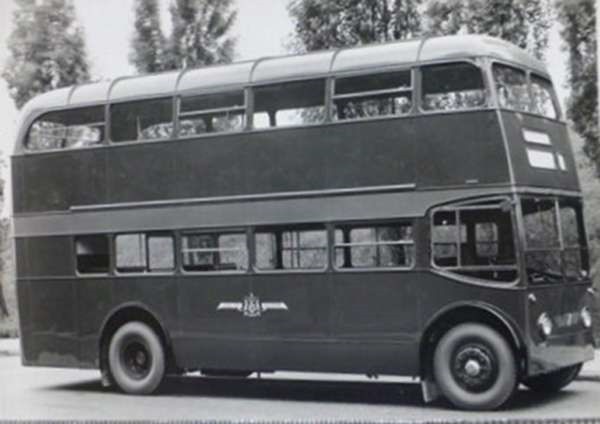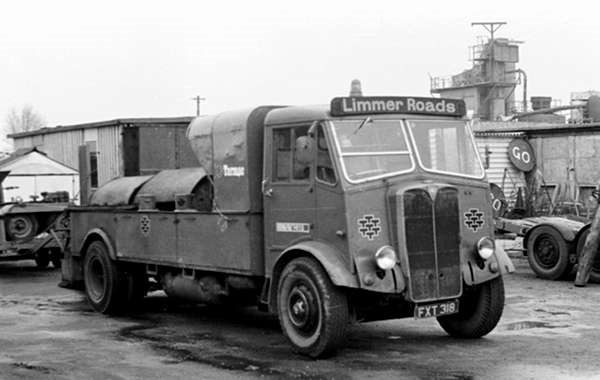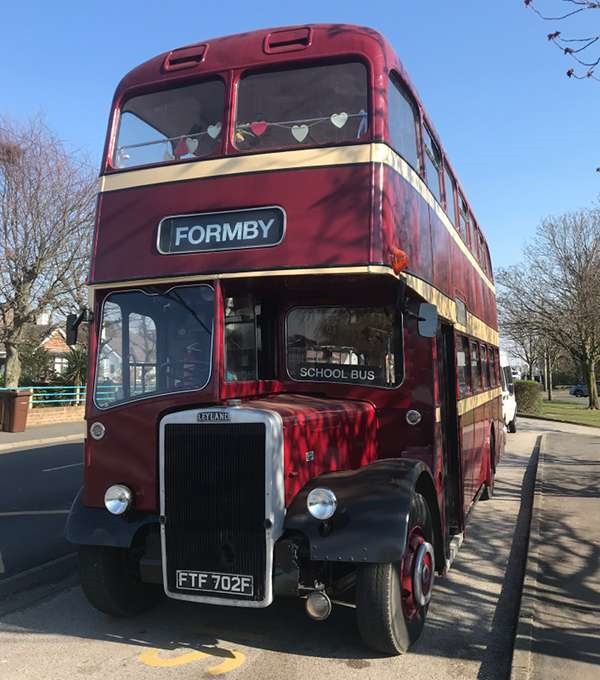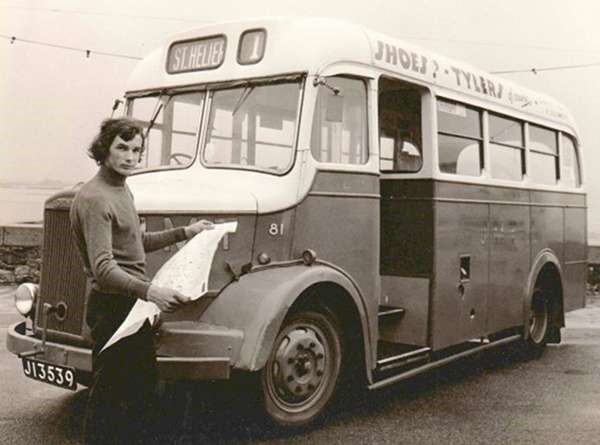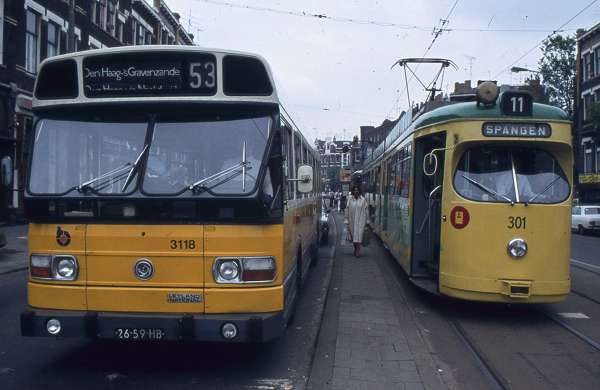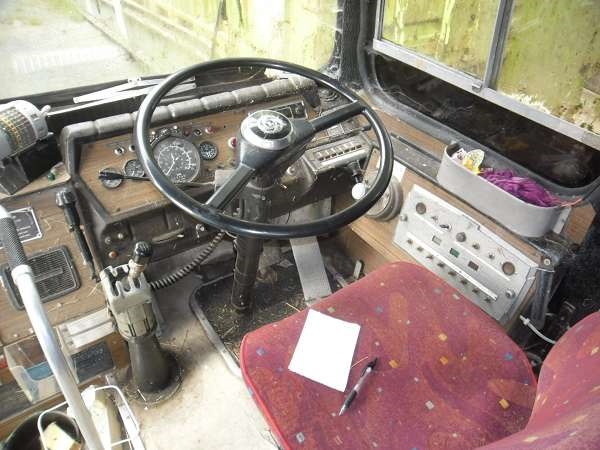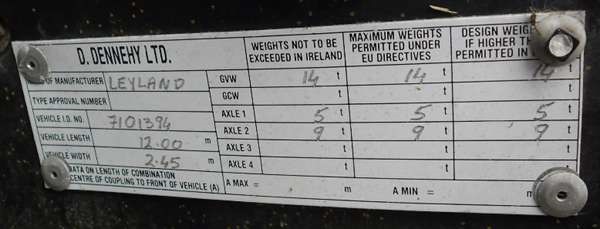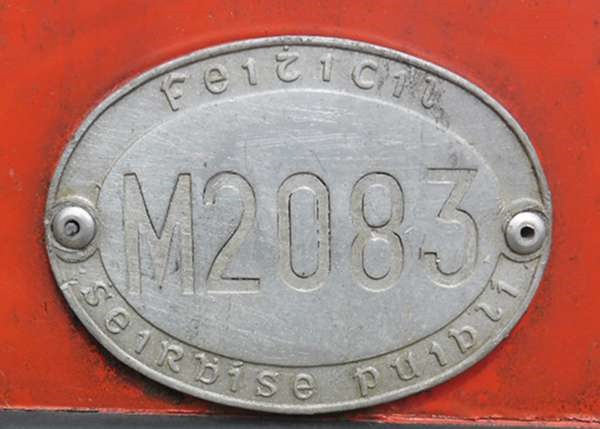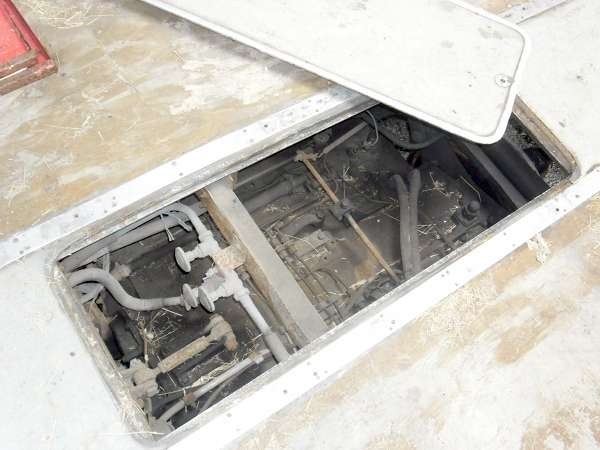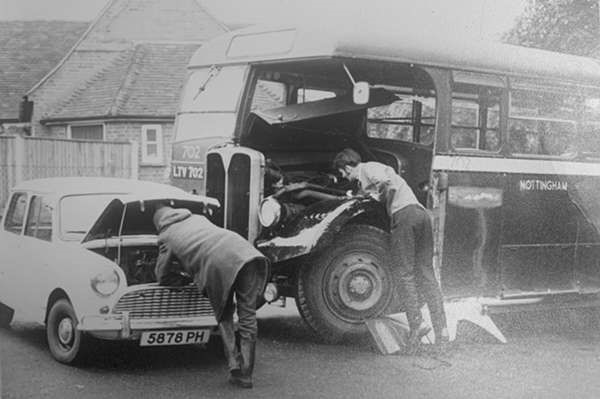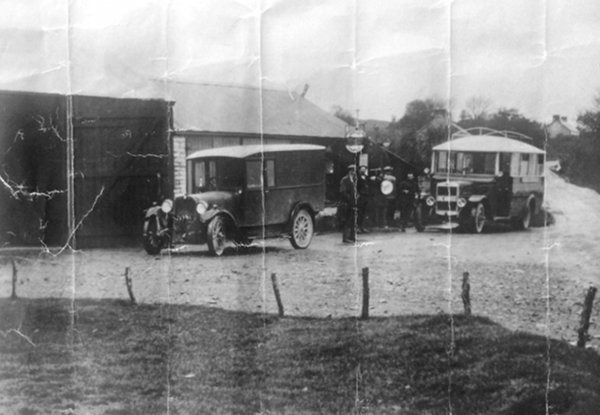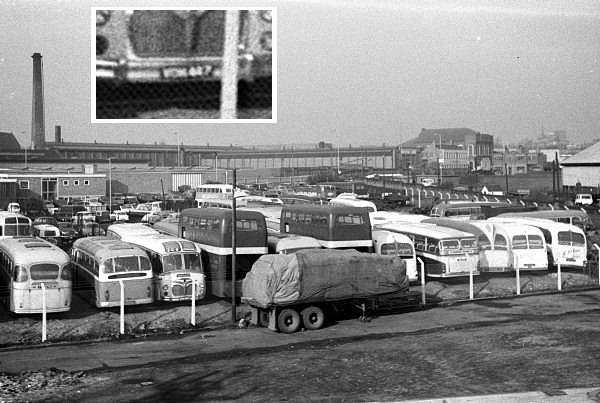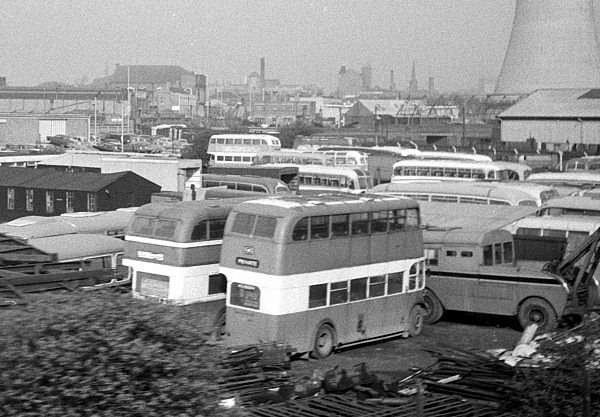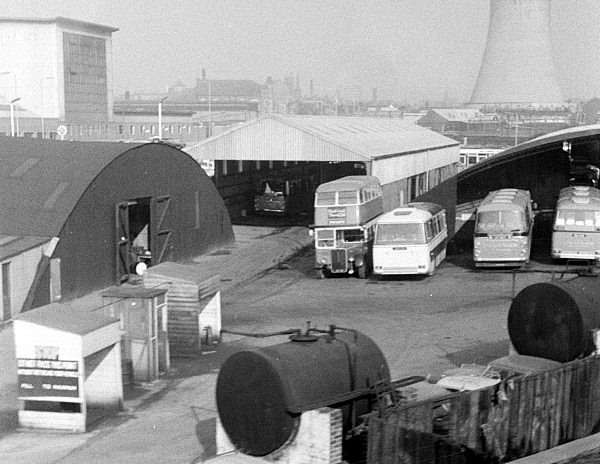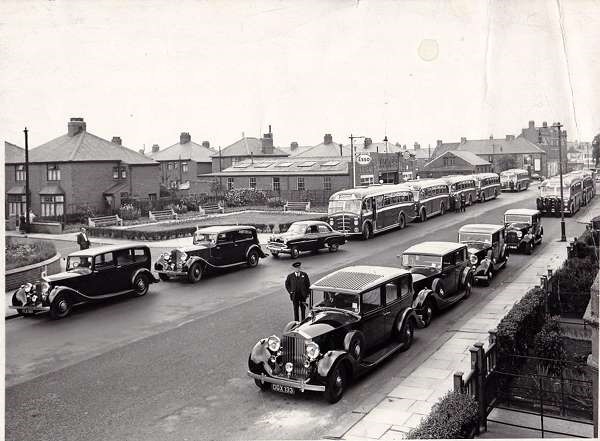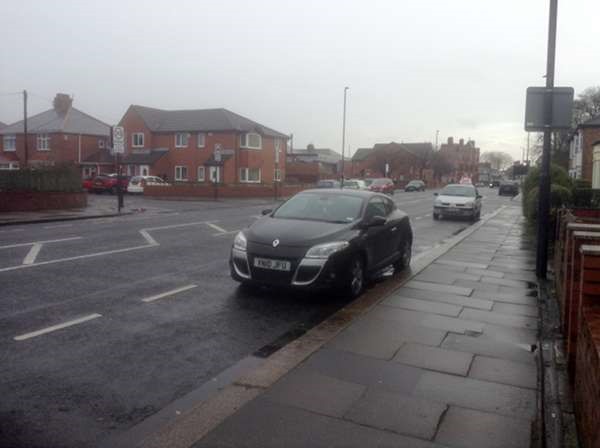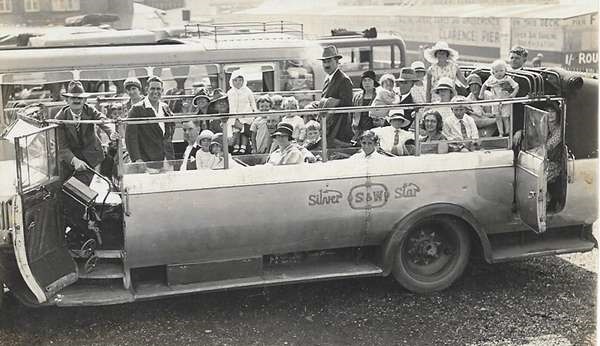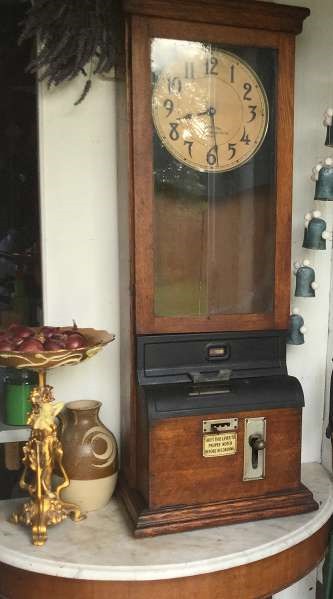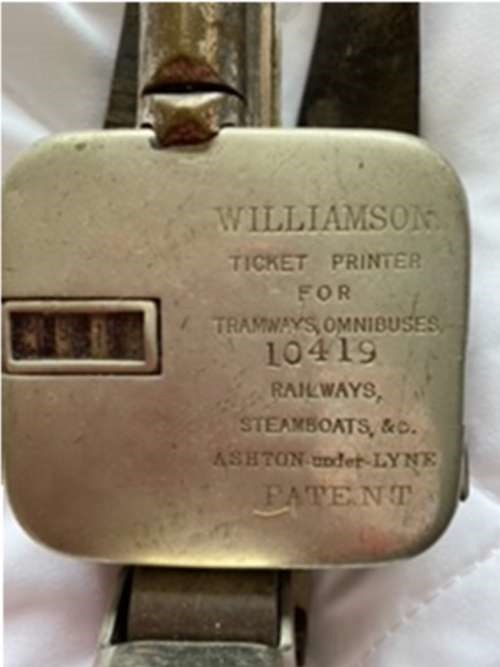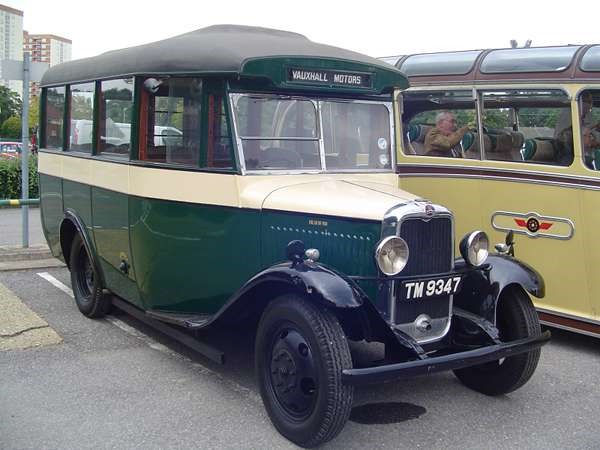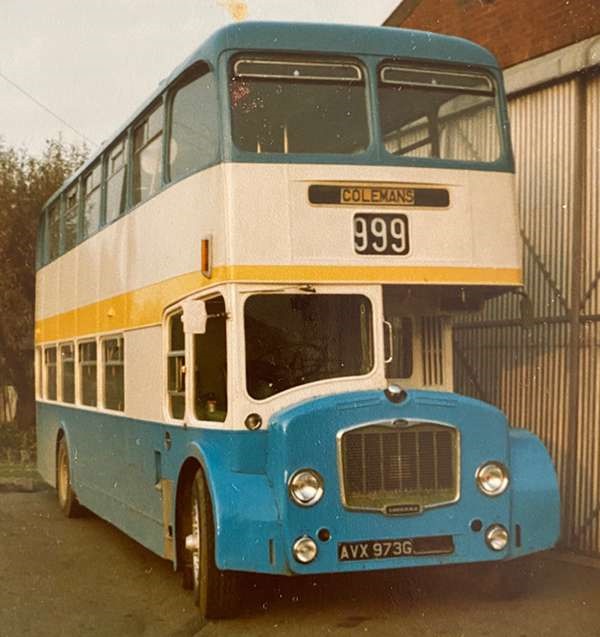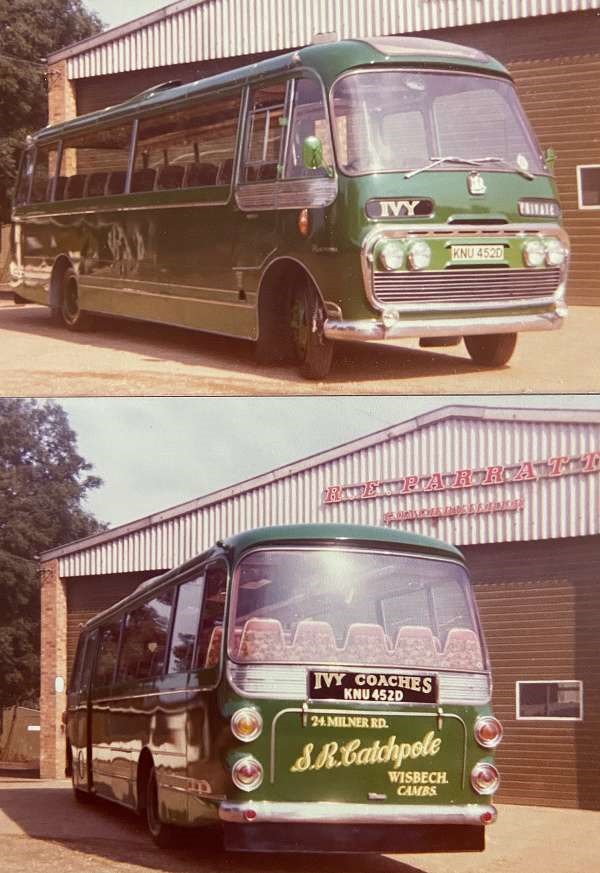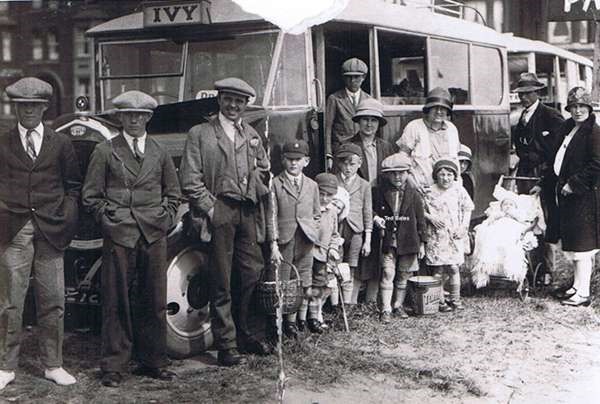Any Other Thing
07/07/22
AEC Regent IV
Until recently I didn’t believe that the AEC Regent IV ever exited but it did! It just never caught on as a bus. They put a Crossley body on it, but that was too heavy. They then tried rebodying it with a Park Royal body, and it was even painted in Leeds City Transport livery, but it did not impress and was scrapped.
David Patrick Walton
If you would like to comment on the above please click here
08/07/22 – 05:25
The AEC Regent IV was conceived in 1949, the chassis layout, with the 9.6 litre engine and preselector gearbox, basically following that of the Regal IV though the frame was slightly lower, resulting in a humped side member over the engine. However, the concept accepted the passenger door being at the traditional rear, and the driving position was set over the front axle, trolleybus style, thereby negating the benefit of the underfloor engine principle. Like that of the Regal IV, the chassis was rather heavy. The first body fitted to the Regent IV was an FH30/30R design by Crossley, a capacity already equalled in several fleets on conventional front engined chassis, and demonstrations during 1950 to a number of operators met with little enthusiasm. See more at this link
A lighter body was produced for the prototype by Park Royal as shown in the picture above, but even then the bus was barely promoted by AEC before it was scrapped soon afterwards. If the design had envisaged a front entrance like the AEC Q, the project might have turned out rather more successfully.
Roger Cox
23/06/22
Pre-war RT Tar Spreader
I came across this pre-war RT tar-spreader conversion at work in Northbourne, a suburb of Bournemouth, in December 1977, and traced it back to its lair in Parkstone, where Limmer also had a similarly converted AEC Regent, I think ex-Nottingham. The photos were taken on 15th December 1977. This RT tar-lorry was last reported to be preserved in Scotland.
Andy Wood
If you would like to comment on the above please click here
27/03/22
FTF 702F
My dad used to own this (Alpha Coaches) and I used to play in it circa 1981 pretending to drive it. I did actually get to drive it on private land when I was 12 and could reach the pedals.
I always dreamt that one day I would own it and was very pleased when Dews allowed me to purchase this bus.
It is still in service today on School Runs and Wedding Hire.
Here is a picture of the bus on the HF6 Thornton to Formby service for Holy Family.
It’s always been a beautiful bus.
Derek Taylor
If you would like to comment on the above please click here
25/06/22 – 05:40
A picture of this bus in Dews ownership is seen here, together with many informative comments concerning its previous history.
https://obp.nwframpton.com/?p=34803
Roger Cox
25/09/21
I wish to find the current owner of my old Buses.
They were a pair of Dennis Pax 24 seater buses running with the JMT in Jersey. I believe they may have started their career in Wales as they were fitted with special rear axle differentials.
I took one of them throughout England, Holland, Belgium and France in the 1970’s, promoting tourism and having fun. They belong to a well know travel writer; George Behrend (Gone With Regret GWR and Paris is Worth a Bus), and I and the last I heard they had been delivered to the LBPG in Guilford before it moved. I have the original hand books given to me by the then CEO of Dennis and the chief engineer who actually built my buses! I do not want them to be lost. I would rather send them to someone who would cherish them. Can you assist?
Rene Paul Gosselin
If you would like to comment on the above please click here
27/09/21 – 05:27
PSV Circle publication PJ1 published Dec 2018 shows J 13539 scrapped at unknown date. Its twin J 13540 probably survives last noted in UK with G. Cortnage then of Four Marks. If you want more info and photos on either please e-mail me through this site.
Ian Everson
27/09/21 – 05:28
If all else fails, Rene, you could consider donating them to the Dennis Society, who hold Dennis Bus Manuals. Their link is: www.dennissociety.org.uk/
Chris Hebbron
04/10/21 – 06:21
These two were the First to be Bodied by Reading of Portsmouth with B21F bodies to come to Jersey. I have travelled many a time in the 1960’s on both on Route 7A. They entered service, 81 – J 13539 on B plate 214 on 25/02/1950, and 82 – J 13540 on B plate 215 on 03/03/1950, both were withdrawn in 10/1969.
John Philip Luce
30/08/21
Fourteen Year Old Boys Bus Trip
Don’t know whether you’d be interested in posting this story of a 14 year old lad’s journey, which I found fascinating and full of photos and titbits of info.
https://www.classicbuses.co.uk/1956journey.html
Chris Hebbron
If you would like to comment on the above please click here
31/08/21 – 06:03
Thanks, Chris, for the link to this fascinating trip report. I’m sure we would all love to go back in time to experience that journey again.
What I find amazing is that Richard Niblett kept such good notes, and that he found them all these years later. Although I never did such a long trip myself, I made two epic one-day trips by local buses on Christmas Eve in 1962 and 1963 (then being 15 and 16 years old). The first was from Whitkirk, Leeds to Hinckley, Leicestershire and the second was from Whitkirk, Leeds to West Ewell, Epsom. I tried to use only local or interurban stage carriage services – resorting to limited stop express services twice. To my shame and frustration, I never kept notes and now my failing memory struggles to remember the routes I took, let alone the buses used.
The reason for making these journeys was to join my parents who had travelled down by car to my relative’s houses where we were staying over the Christmas period. I used to hate sitting in the back seat on those long car journeys, inhaling second-hand cigarette smoke, so I decided to "go it alone". My parents were very trusting and simply accepted my "I’ll see you at about 8pm". Unlike Richard, I didn’t have a collection of timetables to refer to, just a mental map of where to go and what companies to use. How did I know how much money to take? I dread to think what would have happened if I caught a wrong connection or a bus had broken down mid-route in those pre-mobile phone days.
What sort of reception did I get on arrival? Mild indifference from my parents who thought it slightly embarrassing to have such an eccentric son, but admiration from my relatives who considered my epic bus journeys to be worth talking about.
If only I had made notes……..
Paul Haywood
18/08/21
A Dutch Leyland National
Leyland-National 3118 10951/2L
Delivered: 1975
Sold to CAB: May 1984.
Perhaps this picture might be of interest.
Born and raised in Rotterdam I always was a tram and busenthiousiast.
While ‘reorganizing and digitilizing’ my collection I found this picture where we see Leyland National 3118 on route 53 of the then regional bus company Westnederland, painted in the Dutch Railways yellow (almost all of the regional bus companies were part of the Dutch Railways concern at that time, or they owned at least a majority of the shares).
The picture was taken bij Ronald van der Meer on Thursday June 28 1979 in the 1e Middellandstraat. We also see double-articulated tram 301 of the RET on route 11 bound for Spangen. The car is painted in a kind op ‘pop-art’ style.
Westnederland later became part of the Connexxion bus company.
Hans Kloos
If you would like to comment on the above please click here
20/08/21 – 05:20
Interesting posting, Hans – thanks. I think that many of us are aware of the Crossley SD’s supplied to the Netherlands Railways (Nederlandse Spoorwegen) between 1946 and 1949, but I was unaware that there were later purchases of British buses, too. Both the Crossleys and Leyland Nationals were sound vehicles, but both suffered from engines lacking to some extent, the Crossleys in performance and the Nationals in reliability. Looking at the tram reminds me that power pickup was quite different between the Continent and the UK. Pantographs were virtually universal on the Continent, but I can only think of one UK tram operator (Sunderland) who had pantographs fitted. The rest used poles which had to be turned round at the termini! A few operators, London especially, also had under-road pickup.
Chris Hebbron
21/08/21 – 06:07
I’m intrigued by the Dutch windscreen arrangement. Was this as built by Leyland or is it a subsequent alteration. It’s difficult to imagine that the Workington factory would have departed from the highly standardised design at that time. Does anyone know was this a substantial order or just a few for trial?
Ian Wild
21/08/21 – 06:11
I couldn’t help being slightly amused when Chris responded to a post about a Dutch Leyland National by mentioning Dutch Crossleys, because both were actually built by the same company!
Since the Leyland National was – initially at least – a joint venture between British Leyland and the National Bus Company, it needed a dedicated company to build it. For this BL took one of its dormant acquisitions from the past off the shelf, blew the dust off it and renamed it. And the company they chose just happened to be Crossley Motors!
Peter Williamson
22/08/21 – 06:26
This page of "Bus lists on the web" shows a series of 25 Leyland Nationals supplied to various Dutch railway subsidiaries, with fleet numbers in a common series from 3100 to 3124:-
www.buslistsontheweb.co.uk/index.htm?
Interesting to note that they were of the intermediate 10.9m length. That page of BLOTW shows several export orders from the early period of Leyland National construction, including several Australian operators, Jamaica, St Etienne and various operators Norway. The Norwegian vehicles, and most of those for Australia, were also 10.9m long. As far as I recall from reports at the time, the "lantern" type windscreens were a legal requirement, and the buses were built as such.
The early export successes for the Leyland National were well publicised, but I do not recall many repeat orders.
Nigel Frampton
22/08/21 – 06:28
Ian, Wiki states that Nederlandse Spoorwegen in the Netherlands purchased 25 on behalf of their bus subsidiaries NZH, Westnederland, Centraal Nederland and Zuidooster. Problems with windscreen glare resulted in the original windscreens being removed and a different version being fitted.
Chris Hebbron
22/08/21 – 06:36
Peter beat me to it. Leyland National WAS Crossley reborn and the structure WAS one of the best bodies ever built – let down by the 510. [Of course, Crossley were renown for the quality of their bodywork as well.] The National 2 was so much better, almost the Series 3 RE that many would have preferred, with its 680; TL11 and 6LXB offerings.
David Oldfield
02/02/22 – 06:39
A rather belated reply to Chris Hebbron’s comment about current collection on UK tramways. His recollection that Sunderland was the only one to use pantographs is almost correct; traditionally the only other was the much smaller Swansea and Mumbles Railway (which was a tramway despite the name), although Blackpool’s modern double deck trams were also fitted with pantographs. However by no means all the remainder used trolley poles. The large Scottish municipal operators – Glasgow, Edinburgh, Dundee and Aberdeen – all used bow collectors exclusively, as did Leeds in England. There was an odd situation in Birmingham where 50 trams operating routes out of Washwood Heath Depot were also so fitted, although the rest of the system used poles. London Transport used the underground conduit system within the area of the old GLC, although most (?all) cars were also fitted with poles for use on routes sections outside this area. There were also a few oddities, mainly pier tramways, which used third rail collection. Of these only the Giant’s Causeway Tramway was what might be called a ‘normal’ tramway, running alongside roads for a proportion of its length.
Alan Murray-Rust
07/08/21
Leyland Leopard/Plaxton reg no. 355 SZB
Although this coach is just outside OBP terms of reference, I thought it might be of interest since this month is it’s 50th birthday. It is a Leyland Leopard PSU5/4R chassis no. 7101394 with Plaxton Panorama Elite II C37/57F coachwork, body no. 7132961. I am guessing the 2 capacities either refer to standing passengers on a carriage operation or possibly children on school bus use. The coach is 12 mtr long and 2.45 mtr wide.
It was first registered by Rendall, Parkstone in Aug 1971 as PFX 571K. It was exported to Ireland in Feb 1982 for purposes of restoration and preservation. I don’t know who the owner was at that time, but presumably that was when it acquired it’s Irish registration. It must have been looked after well,because there are numerous stickers on the front bulkhead from shows all around UK, including Gosport 2008 & 2009 and Showbus 2012, where it apparently won an award. It has what I believe to be an Irish tax disc which expired in Feb 2016.
So, how and why has it ended up at E J Metal Recycling, Pont Creyddyn, on the A482, Lampeter, Mid Wales? As you can see from the photos, all the seats, with the exception of the very tidy drivers seat, have been stripped out, as has most of the interior trim. There is what I believe to be a ticket machine and possibly a spare on top of the dash. I don’t know where the engine was located on the Leopard, but the side lockers on the passenger side are just empty spaces behind the doors. What I believe might be the transmission is in place under the floor in the centre of the chassis.
There is legal lettering for Rivercourt Coaches International for London and Dublin addresses and a fleet no. 355. I have not been able to find this company. Also there is a cast alloy plaque just above the legal lettering with the number M2083, which might be a PSV licence of some sort perhaps, but then the only indication of the coach being operated by anyone in Ireland is suggested by the Rivercourt Coaches details.
Hopefully someone can fill in the spaces in the coach’s life story and solve the mysteries. For a 50year old coach, the shell looks quite tidy, even having the original tail lights and Irish red rear number plate. There were some initials on the rear glass, which I did not record. I have attached all the photos I was able to take, sadly none of the rear or driver’s side, since I am getting a bit old to be climbing around scrap yards!
David Field
If you would like to comment on the above please click here
09/08/21 – 05:54
The engine on a Leopard was located under the floor, between the axles. You are quite correct in saying that there is a ticket machine (Almex) visible in one of the photos.
Other photos on the web do confirm that the vehicle was "preserved" and rallied within the last ten years, so that it’s current state would seem to be a rather sad end. Unfortunately, your photo, and some of the others on the web, suggest that there is a degree of "body sag" towards the rear end, which would be difficult and/or expensive to put right.
Nigel Frampton
16/08/21 – 05:40
It is a sad fact, particularly to me, that very few coaches are preserved. I was discussing this with some FoKAB people at Stokes Bay recently. Unfortunately, despite building bodywork of a very high quality, until 1976, everything was built on timber/composite frames. These were never as robust as the metal frames used more commonly by bus manufacturers and body sag and collapse was a fairly regular occurrence with older Plaxton, and Duple, bodies which has resulted in very few managing to last as far as preservation.
David Oldfield
17/08/21 – 06:25
Thanks for the comments so far Nigel & David. I have found a rather vague article on Youtube which refers to the rear section of the coach being rebuilt 2011/2012. It didn’t say for what reason – so you might well have answered that question. I believe on the series 1 Leopard the engine was towards the drivers side of the chassis. Was it moved towards passenger side on series2 and if so might that explain the empty space behind the locker doors? One of the floor traps was open and I have attached a photo of that area, which might help answer the question. It seems to me that there is a large amount of trim and glazing in good condition sitting there if anybody owns or is restoring such a coach.
David Field
18/11/21 – 06:23
PFX 571K was acquired in February 1982 by P. Kavanagh, Urlingford from Smith, Buntingford in a dealer capacity. It quickly passed to Michael Butler of Middleton the same month where it was re-registered 355 SZB, remaining with that operator until March 2007. At that time it passed to the Motor Vehicle Preservation Society in Wicklow, run by Stephen Payne who later set up Rivercourt Coaches in Dublin. The London address is a new one on me, although he claimed to also have a coach operation in the US at the same time!! Payne is well known for being associated with the infamous Michael Grimes of the so-called Kells Transport Museum in Cork, as well as having a vivid imagination which could put Walter Mitty to shame!!! Stephen Payne later brought the coach to England, but obviously not re-registered there. The body number is 713296, I have no idea why the legal lettering shows two different capacities.
The M2083 plate is indeed a PSV plate, with "Public Service Vehicle" written in Irish and in Gaelic script.
Shane Conway
31/05/21
Radio Documentary about the Tilling Family
Do you think any of your members would remember travelling on Tilling buses as young children? It’s probably a bit of a stretch given the amount of time that’s passed but the reason I ask is because I’m working on a potential radio documentary about the Tilling family and their horsebus and motorbus business. We thought, if possible, it’d be a nice addition to include the memories of those that can recall the sights and sounds of a Tilling bus chugging along.
Jack Shillito
Media Moment
Contact OBP for email address
If you would like to comment on the above please click here
04/06/21 – 06:14
Maybe you have already read the chapter "The Tinkling Tillings" in "Looking at Buses" by Geoffrey Hilditch. The descriptions in that chapter certainly give a flavour of the ride quality from the passenger’s point of view, as well as a very fair analysis from an engineer’s point of view too. The people at Amberley ought to be approached too as they have Tilling buses there as well. I hope this is of help to you.
Mike Baron
30/06/21 – 06:07
Does he mean buses built by Tilling, or buses operated by Tilling – or possibly both? It might be useful to clarify that point!
Nigel Frampton
07/05/21
Rupert
I can only find these photos of Rupert. One taken in 1973 in a campsite near Akrata on the north coast of the Peleponese in Greece. My sister is the little girl in front and my 10 year old self can just be seen in the cab.
The other is of my father working on Rupert at a farm where it was kept near Basingstoke where we lived. Hope they are of interest to someone.
Pete Broadbere
If you would like to comment on the above please click here
28/04/21
Morgan Bros, Tegryn, Pembs Star Low Loader DE 6662
This picture shows the garage premises of Morgan Bros, Tegryn, Llanfyrnach, Pembrokeshire. The bus is Morgan’s Star Low Loader VB3 chassis VB 909. First licensed on 30th August 1928 and registered DE 6662. It is most likely that the chassis was bought new from Edwards Bros (Ben & John)who were Star main dealers in nearby Crymmych at the time. The twenty-seat body was thought to have been built by Thomas & Thomas in Carmarthen as were many others of the period. In July 1941 it was sold to Thomas Charles Herbert of Maenclochog who used it regularly until the notorious winter of 1947 when it had to be abandoned at the roadside in deep snowdrifts. By the time it could be recovered, weeks later it is said, irreparable damage had been done to the engine by the prolonged below-freezing conditions in a very exposed location. The bus saw no further use despite being kept on Herbert’s premises for another couple of years. Photo copyright owner unknown.
Les Dickinson
If you would like to comment on the above please click here
30/04/21 – 07:06
The Star Low Loader for 20 seat bus bodywork appeared in 1927, later becoming the Star Flyer. With vacuum brakes and a six cylinder ohv engine of 3.2 litres, it had a reputation for speed – around 50 mph. The vehicles were very well made and this was reflected in the prices and the subsequent failure of the business. The Star company was bought by Guy in 1928 and within four years the commercial ranges were dropped in favour of Guy’s own models. A legend then arose that Guy sold the Star Flyer design to AJS who then produced it as the Pilot, but this is now thought to be apocryphal.
Roger Cox
15/03/21
Bristol L Series in Service Macau August 1978
Converting some old 35mm slides to digital I came across this from a holiday in Macau August 1978. I am pretty sure its a Bristol L5G dating from 1949. It was still in service in 1978 and the driver is in the cab.
Alister Mogford
If you would like to comment on the above please click here
17/03/21 – 06:30
If I have read the registration correctly, Gerry Tormey’s Bristol website indicates that it was United Autos LHN 856 L5G.73.163R of 1949 and got to Macau by 1964-5 via Hong Kong. See www.bristolsu.co.uk/
I’m sure Gerry would appreciate a copy of the photo!
Geoff Pullin
13/02/21
Jim Young RIP
It is with sadness that I have to report the passing of Jim Young. Jim had an interest in Jersey and Guernsey Albion’s and Bedford’s and purchased a number of these in his earlier years. He had also recently published a book East Anglian Bus & Coach Operation – a 1963 selection. Although originally from Nottingham Jim died at Southend. I believe Jim was a contributor to Old Bus Photos
John Wakefield
If you would like to comment on the above please click here
09/02/21
Don Everall, Wolverhampton
These are three view of the Don Everall yard at Wolverhampton, taken from a passing train in March 1967. In the first view, of particular interest are the two double deck buses in the centre foreground, which are a pair of the Thames Trader buses built to carry cyclists through the Dartford Tunnel. The third can be seen on the far side of the yard. The detail of the original isn’t quite good enough to positively identify any of the other vehicles. The only one with a partly legible registration (see inset) is the Duple Vista to the left of the double deckers. I have tentatively identified this from Bus Lists on The Web as VDH 447, a Commer Avenger new to Pearson Walsall. It has a fleet name J.C.S. Coaches on the front dome. Does anyone else feel up to the challenge of identifying any of the others.
The second view shows two of the double deck buses used by Everalls for driver tuition. They are JP 6003 (probably), ex Wigan 58 Leyland PD1A/Leyland and HG 8884 ex Burnley 160 Leyland PD1/Weymann.
The third view includes a roof-box RT also, it appears, part of the training fleet.
Alan Murray-Rust
If you would like to comment on the above please click here
06/12/20 – 07:15
Cheshire 184
Walking at Tarrant Rushton in Dorset Saturday and came across ‘Cheshire’ in a barn. Back in the 70’s my brother and his friend used to track and follow all 9 buses 180-189 as they had routes in our hometown of Bournemouth. Often wonder what happened to them all…they were something of an icon!
Joanne Kerr
If you would like to comment on the above please click here
05/12/20
Wakefields Motors at Denney’s Garage Wallsend
This image in my possession was taken sometime during the late 1960’s. The location is Shields Road, Wallsend at its junction with the southern end of Lynn Road. Although I can remember roughly when it was take I can’t remember what the event was about.
The gentleman standing to the left – with hands in pockets – is my late father, who was the Superintendent Engineer responsible for operating the fleets of Tynemouth Transport and Tyneside Tramways buses and Wakefield’s Motors coaches from the late 1930’s until his retirement in May 1966. I have yet to identify the reason for this assembly outside the premises of Denney’s Motors garage. The managing partner of the garage business was Joseph W Denney, standing centre front.
The photographer’s stamp on the reverse is ‘Dickinson’s Photographers Ltd, Wallsend.
I hope you find this of interest.
Neville Mitchison
If you would like to comment on the above please click here
06/12/20 – 06:37
The coaches are 1952 AEC-Beadle rebuilds. These dated from 1952 (based on pre-war AEC chassis) and I have a vague recollection that when they first appeared, they were painted in crimson lake livery, but were subsequently painted cream. If this is correct, then that puts the date of the photo as 1952 or 53, as I think that the 1954 pair were always in cream livery. It should be said though that this was nearly seventy years ago, so I am not too sure how accurate my memory is.
John Gibson
06/12/20 – 15:22
I know nothing about the PSVs shown, but as my father bought a new Vauxhall Wyvern in 1953, I became an observer of the type which changed every year to a small degree. The car between the offside Rolls and the first Beadle coach is a 1955 model Vauxhall Velox (6 cyl) or less likely Wyvern (4 cyl).
Geoff Pullin
06/12/20 – 15:25
Neville, I may be able to narrow it down as to the date. Between 1951/3, NGT refurbished 42 pre war AEC Regal chassis, they were lengthened and widened to 8ft, received A173 – 7.7 AEC engines, and all the running gear was AEC, so to all intents and purposes they were an AEC, but they never carried AEC badges or logos. The chassis were reclassified as NGT/AEC and numbered 132/174.
36 of them were bodied by Picktree, to NGTs own design, 23 as FC35F, and 13 as B43F (the famous Kipper Boxes) However, six of the chassis 143/148 were destined for Wakefields, but they were bodied by Beadle as FC35F.
FT7275/80 – 175/80 dating from 1951.
Another two Beadle rebodies arrived in 1954, FT7791/2 – 191/2, but the origin of their chassis is unknown to me.
If my records are correct (I don’t claim to be infallible).
175/80 were replaced by four Burlingham Seagull 70 bodied AEC Reliance 2MU3RV coaches, that were delivered in May 1961. Along with most of the NGT rebodies, the Beadles were exported to Yugoslavia, of all places.
In 1963, 191/2 were replaced by two Plaxton Embassy bodies Bedford SB5’S, and were sold to Garner Bridge of Weir.
I started at Percy Main in January 1967, and if memory serves, the fleet engineer at that time was called Hutchinson, but we are talking 50 odd years ago, and I could be wrong.
As to the event. This is pure speculation on my part, The Swan Hunter Shipbuilding yard was very close to where these vehicles are parked up. My guess would be that they are official transport for dignitaries attending a launch.
Ronnie Hoye
10/12/20 – 05:56
Up to date view of photo re Wakefield Coaches Denny’s garage in Wallsend.
Neville. With reference to date of photo. The details of others I find interesting.
I would date photo to mid 1950’s (1955) to late 1950’s (1959). The late date of the 1960’s appears incorrect as the Garage Denny’s unknown to me was trading at that time by Addisom Motors of Wallsend selling used cars consisting of almost all Leyland Mini’s. In 1961-1964, selling Petrol and a small garage repairing cars. They were still trading in 1968. Later known as Benfield Motors moving to Benfield Road Addison Motors was the Parent company they recently sold out to the Looker group.
Returning to the photo the Limo’s look pre 1960’s.
Following on from others yearly dates the Coronation took place in 1953 and Ronnie lists Swan Hunters Shipbuilders Wallsend. In 1955 a Royal Vist to Tyneside took place, after launch of ship dignitaries attended lunch at the Swan Hunter named Memorail Hall in Wallsend.
A mile away was ideal place to park cars and coaches required on the day from Denny’s garage to Lynn Road as seen in the photo. I stand to be corrected hopefully this will help date photo unless others have further information. I have been unable to find any detail of Dickinson’s the Photographer.
Alan Coulson
11/12/20 – 06:07
Further to Alan’s comments, the garage no longer sells fuel, but is still trading under the name of Fosters.
Going back to the original photo.
It looks to me as if all 8 of Wakefield’s Beadles are present, and all in the red livery. Just behind the last one on the right is The Avenue, which on the right hand side of the road is the boundary with Newcastle upon Tyne. However, the building on the left are in Wallsend. Confusing, isn’t it.
Beyond The Avenue is Wallsend High Street, the tall building is The Duke of York public house, and if you look closely there is a bus heading towards where the coaches are parked up.
Both T&D and Tyneside had services along this stretch of road.
The bus is either one of Tyneside’s 1954 Orion bodied Leyland PD2’s GTY 139/47 – 39/47.
Equally it could be a T&D Orion bodied GUY Arab,
They had two batches
1954 - FT 7893/6 – 193/6 G5LW GUY Arab III
1955 - FT 9003/6 – 203/6 G5LW Guy Arab IV
Ronnie Hoye
12/12/20 – 06:22
Maybe it was the Queen’s visit to Tyneside in October 1954, which included a stop at Wallsend Town Hall. See this link
Paul Robson
13/12/20 – 07:10
Paul.
Excellent link, I said I stand be corrected.
This firmly gives a date to Neville’s photo.
Alan Coulson
14/04/21 – 06:24
Wakefield’s entire fleet of Beadles captured on the outskirts of the shipyard town of Wallsend along with a fleet of very polished Rolls Royce limousines. The reason for them all being lined up like this may have been for guests being transported for the witnessing of the launch of a ship.
Another reason put forward, is that the transport manager of Tynemouth District Omnibus Co. and of Wakefield’s, lived in one of the streets in the background at the time. The photo was taken before all of the Beadles were repainted in mainly cream with red skirts and flashes which would have been about 1955. A Tyneside Tramways PD/12 is in the distance with Orion bodywork one of nine which were purchased in late 1954 and had GTY 139/47 registrations.
Ray Jackson
22/11/20
North Western Fleetlines
Does anyone remember 189 with it’s Cummins V6. It had a slightly longer body because of the larger engine shroud to accommodate the Cummins. Boy did we have some trouble with this bus. Firstly it kept conking out. We suspected that someone put something in the tank, we thought it was sugar but we were never sure. After draining and removing the tank steaming it out we had to put three filters in the fuel line. All the injectors kept gumming up on it. What a palava that was. Next it suddenly lost all it’s power. If it was on the 90’s it would get stuck at Marple Bridge if it had more than a handful of passengers. It could not climb Brabyns Brow. We tried everything to find out what was the matter with it. It took ages to find out what it was. I took it to the Cummins agents at Ashton in Makerfield. They couldn’t make head nor tail of it. The power output was fine. Reluctantly I set off home. On the way back to Stockport I came up the M6 to Knutsford so as to come back Altrincham way. To my amazement it wound up to nearly 70 mph on the motorway but lost it on every pimple. The speedo only went up to 60 and it was off the clock on the level stretches.
Well what a puzzle! After a lot of discussion on my return to central works we had a brain wave. What if it had the wrong diff in it. We discovered that indeed the original diff had been removed after we checked the records and a spare one had been installed. That was when the penny dropped. The diffs in the Gardner engined Fleetlines was a higher ratio than the one in the Cummins engined one. The Cummins must have had a completely different ratio gearbox coupled to the engine. When we found the correct diff and swapped it over all was well. We all gave a big sigh of relief. The problem with it had gone on for months. I was beginning to think 189 was cursed. I found that in general the problem with having these trial engines in the buses was one we were groping about in the dark to keep them running. 555 the Ruston Hornsby vertical air cooled and 969 the horizontal Ruston were examples of this. Although the Ruston Hornsby’s didn’t give much trouble. I remember 969 having the cylinder head gaskets changed when one failed. It was a bit odd because it had one gasket for each of the 6 cylinders. The cylinders were like the cylinders on a motorbike with fins. For those that never heard the Ruston Hornsby they sounded very metallic. The cooling fans made a right racket sucking air in possibly more so on 555 in the PD as it was right at the front at the grill.
I was glad when Chief Engineer decided to put a Gardner back in Fleetline 189 though but I did miss it’s engine sound. It was very American like the sounds we hear on films of large American trucks. A very deep throb.
That reminds me I forgot to remind the Chief to change the diff for one compatible with the Gardner engined version. I bet it only did about 25 mph flat out when it received the Gardner 6LX. Don’t know who got it when Selnec took over and everything was calved up.
I can’t remember! Put it down to old age
It’s too late now anyway, it was 40 odd years ago.
Graham Roby
If you would like to comment on the above please click here
25/11/20 – 07:43
189 went to SELNEC.
Stephen Howarth
25/11/20 – 07:45
I would imagine that at least part of the problem with the gearing of the Cummins engine in 189 would be engine speed. Gardner-engined vehicles had to be geared to take account of the 1700rpm limit, whereas a Cummins V6 would probably go up to something like 2600 at a guess. The torque peak revs would also be correspondingly higher, requiring lower gearing for hill-climbing as well.
Peter Williamson
14/10/20
Silver Star Excursion Clarence Pier Circa 1929
I thought you may like the image of an old family photo! Looks as though it had just arrived at Clarence Pier in Portsmouth circa 1929/30.
Slightly different a convertible.
I understand that a photo was taken on arrival for the passengers to purchase.
Frank Rhodes
If you would like to comment on the above please click here
16/10/20 – 06:01
This is a fascinating picture. The Clarence Pier area in the background looks nothing like the area I knew – but it was 30 years or so earlier! Probably no big wheel or dipper there then – was there a fairground there at all? But coaches did park there in the 1950’s and 1960’s, and probably later, too, so that’s continuity.
I think this coach body style was called an "all-weather" coach. with the folding roof able to be folded right back for sunny days, and pulled forward for that summer shower [or worse!].
I’m assuming that this Silver Star is the one based at Porton Down, Salisbury. This is borne out by the "S W" initials between the fleet name. This firm was run by Messrs Shergold and White, and post-WW2 was famous for it’s forces services, and for being the first independent operator to purchase new Leyland Atlanteans – I remember seeing them on visits to their area, and the livery made them even more impressive. It was a sad day when they ended their operations and sold out to Wilts & Dorset in 1963. In retrospect, it’s good to remember that W&D continued to operate many of the buses and coaches taken over, although the Atlanteans moved on to Bristol OC.
Michael Hampton
16/10/20 – 06:03
The easy bit is the operator, Eddie Shergold & Ben White trading as Silver Star Motor Services of Porton Down and Salisbury.
The difficult part is the vehicle. My guess is MR8049, an Albion Viking with London Lorries C28D bodywork new in 1926.
Nigel Turner
16/10/20 – 06:04
This is, of course, a very early photo of the famous Silver Star, who ran services around Salisbury and had a very lucrative coach business in the postwar years, running predominantly Army National Servicemen home for the weekends.
This would have quite a run from Wiltshire to Southsea in 1929, on the roads of the day. Clearly they had good weather on this occasion!
Chris Hebbron
17/10/20 – 06:27
Following on from Nigel’s post, Duple took over London Lorries in 1932.
Chris Hebbron
17/10/20 – 06:29
This photo puzzles me. Normally, charabanc tours operated from railway stations or resort centres to take day trippers out into the countryside or to a beauty spot. It seems strange that tourist would load at Clarence Pier as the only visitor arrivals at that time would have been from the Isle of Wight ferries. Is it just possible that this charabanc is at Ryde (or another IOW port), about to take ferry arrivals on a tour of the Isle of Wight? The sign in the background seems to be advertising Clarence Pier as a destination rather than stating the location.
Somehow, I can’t see IOW tourist coming back onto the mainland to have a tour of Hampshire (no disrespect to that fine county).
I can’t find any reference to Silver Star operating on the IOW, but business-wise it would have made more sense than offering trips from Southsea, having to negotiate the built-up environs of Southsea and Portsmouth before reaching the countryside. Equally, a charabanc trip from Silver Star’s base at Porton Down to Southsea (or vice versa) can’t have been a paying or attractive proposition. Maybe a silly idea, but worth thinking about?
Paul Haywood
18/10/20 – 07:02
One small point – The stance of the two men in trilby hats suggests to me that they are alighting, not boarding. This is particularly true of the man holding the fold-up pushchair. Would he be likely to ascend the steps backwards carrying the awkward load behind him? The other chap with overcoat over his arm likewise seems about to get off rather than sit down.
Stephen Ford
18/10/20 – 07:03
I see no reason why Southsea can’t be the destination for this charabanc trip, and not the starting point. I have recently been reading the histories of Newbury & District, and Red & White, and both of these firms, with their associated companies [both have complex histories] ran tours and express services to Southsea from their respective areas from the early 1920s. The actual destination(s) in Southsea are not specified, but Clarence Pier would be a valid choice, or further along, at South Parade Pier. However, as I mentioned earlier, there was a coach park at Clarence Pier in the 1950s and 60s, and it’s quite possible there was one there from earlier days. From there, a walk along the promenade and beach, or to the Palmerston Road shops, or along Southsea Common, would be perfectly valid as an excursion from the inland areas, including Salisbury.
Michael Hampton
19/10/20 – 06:01
Yes, Stephen and Michael, you’re right, my idea was clearly wrong. I knew I should have thought first and written later.
Paul Haywood
19/10/20 – 06:02
As late as the 1990s there was a coach park, for incoming Day Trippers, just behind the Pleasure Garden/Fair. I took my choir there from High Wycombe in G42, Cliff’s Coaches 1990 Scania K92/Duple.
David Oldfield
19/10/20 – 06:03
As Michael H says, Southsea was a very popular resort to go to for day trips, to the point where, in its heyday, a large area of Southsea Common, by Clarence Pier, was utilised for vehicle parking, and my abiding memory was regularly seeing a dozen or so London Transport RTs, both red and green, parked there, proudly displaying their parent garage on their blinds, being used by garage staff and their families for a Sunday day trip, a busmen’s holiday indeed! Two green one I recall were from Watford Garage, some 87 miles distant; a long journey-time indeed, since an RT was barely able to do much more than 40mph! I can imagine regular stops for the call of nature and increasingly desperate cries from the kids of, "Are we there yet!" The climb up and round the Devil’s Punchbowl to the stop at Hindhead would have been a relief in more ways than one!
Chris Hebbron
20/10/20 – 06:18
I’ve been thinking further about this, and in the mid- and late 1920s, Clarence Pier must have been quite a busy place. Not only would tourists have been able to walk across the Common or to the shops, they would also have taken the regular tram ride from the Pier along the Terraces and in to the main shopping area of Portsmouth. Also, the Corporation had their five Guy J toastrack runabouts, which for each summer season from 1924 to 1938/39 took willing tourists from there all along the sea front and back. It’s possible that tourists arriving from elsewhere in early to mid-morning could also fit in a ferry trip to the Isle of Wight and back for a part-day out in Ryde, as it was only about a 1/2 hour trip each way by boat. You would just have to ensure you were on a return ferry in good time before your chara left!
I think the photographer had a nice little business going in the summer months. He could turn up at the coach park, enter each chara as it arrived, sell his wares for wonderful display photos for a great day out. He’d take his pictures, note who wanted what, and then depart for his lab by lunch time. Then he’d work through developing everything, and return to the coach park in time for the happy tourists to collect their souvenir, and he to collect their money. A nice little earner!
Michael Hampton
21/10/20 – 06:53
You paint a good picture of Clarence Pier and the seafront in the ’20’s, Michael. At this time, there would have been one of the single deck Toastrack trams also appearing at Clarence Pier and, no doubt, South Parade Pier as well.
I’ve never seen a photo of the Guy J Toastracks, but here is a photo of one, courtesy of the Guy website, of what were called Guy Promenade Runabouts and supplied to Portsmouth, Bournemouth and other resorts. The small wheels allowed a low boarding position. They mainly held 14/15 folk. Available from 1922 and in service in Portsmouth in 1924, they were withdrawn between 1939 and 1941.
Chris Hebbron
25/10/20 – 06:03
I was interested in your mention of the Newbury company. That was owned by my Great Uncle and my Mum (still alive and living in Portsmouth) remembers it coming to Southsea and going down to see the family. I have a photo I’m happy to share but I hadn’t realised that they were taken to make money. Of course that makes sense. He used the vehicle as a removal van out of season. The family had a habit of calling the next child by the name of the previous child that had died so it is a little confusing but really happy to find that book in the Reading library (when I was working there) that is mentioned in the notes. My Mum is sorting out old photos so there may well be some others.
June
18/11/20 – 06:17
I was just looking at the photo of all the people sat in the charabanc off on an outing and the driver in his cap with a white cover. It reminded me of a story my grandmother once told me about the day they went to Blackpool in a charabanc like the one in the photo. They sat behind the driver for the trip. On the way back the driver leaned over his shoulder and said to my grandmother "madam can you please turn mi hat round" My gran thought it was a bit odd but with the wind and everything she said "Certainly" So they drove on for a while, the driver with his hat back to front. Finally after a few miles he turned round further and said over his shoulder "Madam" so my gran leaned forward "I said can you please pass mi hat round." My gran had completely miss heard him with all the wind noise and rattling with the solid tyres.
I bet he must have thought what is this daft woman doing turning mi hat round. People were so polite and formal then, no body said a word and he just accepted that his hat had been spun round and carried on with his driving Nowadays people walk about with their baseball caps back to front and no body bat’s an eyelid but then it must have looked quite odd.
Graham Roby
10/10/20
Time Recording Machine
This time recording machine came from the West Riding bus company Wakefield depot, does anyone have any period photos of it in situ?
Derek Greenacre
If you would like to comment on the above please click here
05/10/20
Ticket Machine
I have an old ticket machine, does anyone know of anywhere it could be displayed with other Memorabilia?
Sue
If you would like to comment on the above please click here
06/10/20 – 06:34
You do not say where you live Sue.
But there are many Transport museums around the Country who may like it for display, they may also make use of it during vintage running days to make the vehicle and feel more authentic.
Perhaps you could tell us the area you live in.
Stephen Howarth
19/09/20
Clear Out Picture
I came across this picture whilst having a clear out. I think I took it sometime in the early 1960’s outside the North Western Road Car Company garage in Urmston, Manchester. I hope it may be of some interest to
Alan Stansfield
If you would like to comment on the above please click here
17/11/20 – 06:18
I never remember radiators being that shiny on these vehicles on actual service.Nor do I remember the headlight chrome being so shiny either come to that. When I was 15 I was an apprentice at Altrincham garage then I moved to Central Works to complete my apprenticeship. I loved these Bristols. One time I tried to polish the radiator on one of them with chrome polish I never was able to get it shining like the one in the photo.They seemed to be made of a sort of gun metal.
It is as though the one in the photo has been specially chromed for some reason but I can’t think why that would be.
Graham Roby
18/11/20 – 06:22
The same thought passed my mind when I saw it at first. They look new and out of keeping with the bodywork. I wonder if it had suffered a serious front end accident and had just been rebuilt with new parts.
Geoff Pullin
19/11/20 – 06:25
Well Geoff I never remember a new Rad being purchased. We did have one of our Bristol that had an accident with a cement lorry in Altrincham. It nearly cut the cement wagon in two. The Rad on the bus was cracked on both sides. We had to change the Rad. They sent us over an overhauled one from Charles St. I remember helping to fit it. They had a good supply of spare rads outside the radiator shop. They needed them because up to the mid 60s North Western would not buy antifreeze and the Bristols had to be either drained at night or left ticking over if they were parked outside.Inside the garage at Oakfield St it was not much warmer.The parking area outside had houses all round. As I remember 1960 was a very very cold winter. It was my first winter as an apprentice. Water in the Bristol radiators was freezing even out on the road and tubes were going left right and centre. However as we took one rad off and sent it to Central Works the Land Rover always returned with a reconditioned one so I knew they had a plentiful supply.
There was one garage that never had a frozen Rad. That was Buxton. It was years after I found out why. I was chatting to one of the fitters from Buxton when I was in my 20s and had become the companies fuel injection engineer. I asked him why, before they started using antifreeze Buxton cars never had a freeze up. He solved the puzzle there and then. Oh! he said we used to put a handful of Soda Ash in the rads from the lime quarries they never froze up then. It was also good he said for the water pumps too.Water pumps lasted far longer there than at any other depot but we never knew why until then. Buxton kept their little secret for years.
Buxton people were ever resourceful as they had to survive in extreme conditions in winter.Someone must have discovered how to stop water freezing in rads in the Peak District.
In other areas such as Oldham or Glossop, If we had a bus that got stuck in the snow we were always told to slash the hoses to drain them if they had to be left.
North Western were more than thrifty with their spending of cash in those days.i think after the winter of 1960 they re thought about the advantages of antifreeze.
Graham Roby
19/11/20 – 06:27
The picture is no later than 1960, the year this bus was withdrawn.
Phil Blinkhorn
19/11/20 – 06:28
My stepson regularly cleans aluminium radiator surrounds to that level of shine. Secret is using abrasive discs then finishing off with polish.
Roger Burdett
07/09/20
Bedford WHB TM 9347
This little Bedford the first WHB chassis No 100001 is being auctioned off by the Vauxhall Heritage Centre (VHC) at Luton in an online auction by Brightwells from 21st to 25th September. https://www.brightwellslive.com/lot/details/488740 The VHC are apparently reducing the collection prior to a move to new premises, the existing site at Osbourn Road is being sold for development. Vauxhall are now part of the PSA Group.
John Wakefield
If you would like to comment on the above please click here
26/09/20 – 13:42
For those who maybe didn’t follow this rare machine you may be interested to know it sold at Brightwells Auction (after 191 bids) for £35,700, which I thought a very reasonable price.
Nigel Edwards
27/09/20 – 07:04
Dare I ask – do we know if it is staying in this country?
Stephen Ford
17/12/20 – 05:58
I took this photo of a Bedford WHB on trade plates during the 1969 Brighton HCVC run. Is it the same vehicle?
Roger Cox
22/12/20 – 11:46
Yes its staying local in Bedfordshire with the Smith family of Woodside Garage, Maulden
John Wakefield
23/07/20
Memories of the Past
The above Lodekka owned by Colemans of Leverington in the late 1970s, was a pleasure to drive. The low geared but positive steering together with the smooth semi automatic gearbox, and backed up with a 180 Gardener under the bonnet, made it well capable of the task.
By comparison, some lorries in the late 1960s and throughout the 1970s had the same engine to haul loads of up to 20 tons. Needless to say, a piece of cake for this LD.
A 1966 Bedford just received a smart new paint job by local company R E Parratt of Tydd St. Giles, Cambs. S R Catchpole (Stan) was the owner/driver of Ivy Coaches, Wisbech.
I also drove this particular coach on several occasions.
Piers Minall
If you would like to comment on the above please click here
05/11/21 – 06:45
Here is a previous Ivy coach that took a party from Gorefield near Wisbech to Hunstanton.
Peter Thatcher
22/02/20
Taylor’s Coaches – Cambridge
I was wondering if anyone could help point me in the right direction. I’m trying to find a photo, unlikely I know, but of my Grandad’s company. Back in the 50/60’s he ran a company called ‘Taylor’s Coaches’ in Cambridge, possibly listed as Trumpington as that’s the area of Camb they lived. The type of bus was a ‘Bedford Duple’.
Is there anywhere/anyway I might be more likely to find any information or photos? Or is it unlikely unless it was a local/council bus service?
Thank you for any help or advice you might be able to offer.
John
If you would like to comment on the above please click here
23/02/20 – 06:52
I have not found any photographs but can provide details of the coaches.
J. Taylor, 109 Paget Road, Trumpington had three Bedford OBs with Duple C29F bodies:
HYN 480 from October 1950 to June 1954
HVM 98 from November 1952 to June 1957
VME 296 from June 1954 to March 1963
He also had a Bedford OY with a Thurgood C29F body GVE 586 from June 1955 to June 1958
John Kaye
26/02/20 – 06:42
GVE 586 the Thurgood C29F bodied Bedford OLBD (not OY) chassis No13002, body No 516 was new to Kenzie of Shepreth 11/48. This was an OLBD lorry chassis that was modified but the then young Cyril Kenzie for psv use and then sent to Thurgood of Ware for bodying. It went from Kenzie in 4/49 to Carter of Kentford. It was Kenzies first new coach. Although I have lived in the South Cambs area near Trumpington all my life, I have never heard of Taylor of Trumpington, and they are not mentioned in Paul Carters Cambridge 1 and 2 books.
John Wakefield
18/11/21 – 05:43
Bedford OB VME 296 was apparently used in the film ‘Ring Of Spies’, made in 1963 but not released until 1964. It seems likely that it was so used immediately after its time with Taylor’s. //www.busesonscreen.net/
David Call
11/01/20
Advice Urgently Needed Please!
We have inherited a lot of books, cards and photos of buses, trams and trolley cars from our lovely father who passed away and have no idea of their value or what to do with them. Can anyone help please?
Mrs M Goodfellow
If you would like to comment on the above please click here
11/01/20 – 21:18
If you would like to give an area/location (NOT your address) I am sure one of the helpful contributors on this site would be glad to advise, assist you.
My siblings will be faced with just such a dilemma, with my collection, in the not too distant future – I fear!
Nigel Edwards
12/01/20 – 09:47
I’ve had this problem in both the field of aviation where a friend died intestate leaving over 18000 slides which were classed as chattels outwith his estate and when my brother in law died leaving around 75 model buses and a large amount of model railway items.
First the bad news. There is likely to be little in terms of monetary value. Specialist dealers, even individuals, think that disposal of such items after a death gives the opportunity of easy pickings and their often derisory offers don’t cover your costs of advertising.
The good news is there are societies and individuals who would be interested either in the collection as a whole or in individual items and are prepared to offer a reasonable price or accept the items as a donation.
There is always e-bay which regularly has such items listed for sale.
If you wish the items to go to a "good home" your best bet is as previously advised to post a locale on here and see the response.
Phil Blinkhorn
